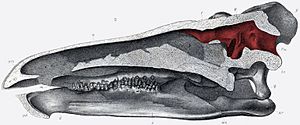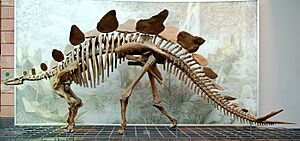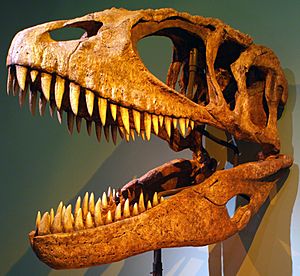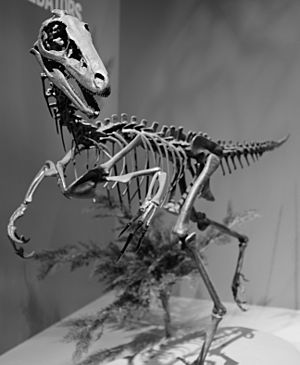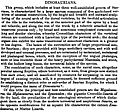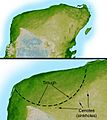Dinosaur brains and intelligence facts for kids
Dinosaur brains and their intelligence are fascinating subjects! For a long time, people thought dinosaurs were not very smart. But now, scientists realize that some smaller meat-eating dinosaurs were actually quite clever for reptiles. This new understanding sometimes led to exaggerated ideas in movies, like Jurassic Park.
Contents
Stegosaurus Brains
You might have heard that Stegosaurus had a "brain the size of a walnut". This isn't quite right. Its brain was actually about the size of a dog's. But compared to its huge body, the brain was indeed very small.
In the 1880s, a well-preserved Stegosaurus skull allowed a scientist named Othniel Charles Marsh to make a cast of its brain cavity. This cast showed that the brain was tiny. In fact, it might have been the smallest brain among all dinosaurs, compared to its body size. An animal weighing over 4.5 tonnes (5 short tons) had a brain of only about 80 grams (2.8 oz). This small brain led to the old idea that all dinosaurs were unintelligent. However, scientists mostly disagree with that idea now.
Marsh also noticed a large canal in the Stegosaurus' hip area of the spinal cord. This space could have held a structure up to 20 times larger than its small brain! Some scientists thought this might have been a "second brain." It could have helped coordinate the back part of the body, perhaps for defense against theropod attacks. But there is no direct evidence to prove this "second brain" idea.
Brain and Body Size
Generally, bigger animals tend to have bigger brains. This means brain size and body size are usually connected. However, this connection isn't always straightforward. For example, small mammals often have brains that are relatively larger compared to their body size than big mammals do.
Mice have a brain-to-body size ratio similar to humans (about 1/40). But elephants have a much smaller ratio (about 1/560). Even though their brains are proportionally smaller, elephants are clearly very intelligent animals.
Encephalization Quotient (EQ)
To better compare intelligence, scientists use something called the Encephalization Quotient (EQ). This formula tries to figure out how big an animal's brain is compared to what's expected for its body size. The formula is often given as Ew(brain) = 0.12w(body)2/3. This formula is based on data from mammals, so it might not work perfectly for all animals.
What is Intelligence?
It's hard to measure how smart animals are. But generally, the larger an animal's brain is compared to its body, the more brain power it might have for complex thinking tasks. The EQ formula helps rank animals based on their brain size relative to their body. This ranking often matches how complex an animal's behavior is.
For mammals, the average EQ is around 1. Animals like carnivores, cetaceans (like dolphins and whales), and primates (like monkeys and apes) usually have an EQ above 1. Animals like insectivores and herbivores often have an EQ below 1. Humans are at the very top of this list.
However, the connection between brain size and behavior isn't perfect. Other things also affect intelligence. For example, the development of the cerebral cortex (the outer layer of the brain) and how much the brain is folded can increase its surface area. More folding is linked to higher intelligence in humans.
Dinosaur Brain Studies

Challenges with EQ
When scientists first tried to estimate dinosaur brain size, they often used the volume of the brain cavity inside the skull. This is called an endocast. But there's a problem: the brain of a modern reptile like the Sphenodon only fills about half of its brain cavity. Some paleontologists used this 50% estimate for dinosaurs.
However, other scientists noticed that details inside the skull showed that some fossil reptiles had brains that filled much more of their brain cavity. Also, the way brains changed from reptiles to birds means we can't use a single fixed ratio for all dinosaurs.
Another challenge is estimating a dinosaur's actual body mass. One study found that the body mass for many dinosaur genera could vary by four times! This wide range of body mass estimates, combined with the uncertainty of how much of the brain cavity the brain filled, makes it hard to get an accurate EQ for dinosaurs.
Because of these difficulties, scientist Hans Larsson tried a different way to compare brains. He focused on the proportions of different brain regions. The cerebrum, which is important for intelligent behavior, is clearly marked inside skulls. Larsson compared the size of the cerebrum to the rest of the brain cavity. He believed this method was better than just comparing brain volume to estimated body mass.
Theropod Brains
Most dinosaurs, including many theropods (meat-eating dinosaurs), had brains that were similar to modern reptiles. This is based on what scientists can estimate.
In a 2001 study, Hans Larsson looked at the brain cavity of Carcharodontosaurus saharicus. He found that both C. saharicus and Allosaurus had a cerebrum-to-brain volume ratio very similar to modern non-avian reptiles. However, the Tyrannosaurus brain showed a slight shift towards a more bird-like proportion. Since tyrannosaurs are early coelurosaurs, this suggests that the group Coelurosauria began a trend of brain enlargement in theropods.
Troodon
The cerebrum-to-brain-volume ratio for Troodon was quite interesting. It was about 31.5% to 63% of the way from a non-avian reptile brain to a truly bird-like brain. This suggests Troodon was smarter than many other dinosaurs.
Archaeopteryx
Archaeopteryx, an early bird-like dinosaur, had a cerebrum-to-brain-volume ratio that was 78% of the way to modern birds. This shows a clear progression in brain development towards birds.
Summary
Larsson's study didn't use the EQ formula. Instead, he compared the size of the cerebrum to the entire brain. The cerebrum is the part of the brain mainly responsible for what we call 'intelligent behavior'.
Overall, the brains of most dinosaurs were similar in proportion to other reptiles. The main exception was the coelurosaurs. These dinosaurs had cerebra that were proportionally larger than most reptiles. However, their brains were still proportionally smaller than those of modern birds. This shows an interesting evolutionary trend in dinosaur intelligence.
Images for kids
-
Birds are avian dinosaurs, and in phylogenetic taxonomy are included in the group Dinosauria.
-
Sir Richard Owen's coining of the word dinosaur, at a meeting of the British Association for the Advancement of Science in 1841
-
Paleontologist Robert T. Bakker with mounted skeleton of a tyrannosaurid (Gorgosaurus libratus)
-
Scipionyx fossil with intestines, Natural History Museum of Milan
-
The early dinosaurs Herrerasaurus (large), Eoraptor (small) and a Plateosaurus skull, from the Triassic
-
Restoration of six dromaeosaurid theropods: from left to right Microraptor, Velociraptor, Austroraptor, Dromaeosaurus, Utahraptor, and Deinonychus
-
Restoration of four macronarian sauropods: from left to right Camarasaurus, Brachiosaurus, Giraffatitan, and Euhelopus
-
Restoration of six ornithopods; far left: Camptosaurus, left: Iguanodon, center background: Shantungosaurus, center foreground: Dryosaurus, right: Corythosaurus, far right (large) Tenontosaurus.
-
An adult bee hummingbird, the smallest known dinosaur
-
A nesting ground of the hadrosaur Maiasaura peeblesorum was discovered in 1978
-
Restoration of two Centrosaurus apertus engaged in intra-specific combat
-
Restoration of a striking and unusual visual display in a Lambeosaurus magnicristatus
-
Nest of a plover (Charadrius)
-
Fossil interpreted as a nesting oviraptorid Citipati at the American Museum of Natural History. Smaller fossil far right showing inside one of the eggs.
-
This 1897 restoration of Brontosaurus as an aquatic, tail-dragging animal, by Charles R. Knight, typified early views on dinosaur lifestyles.
-
Comparison between the air sacs of an abelisaur and a bird
-
Various feathered non-avian dinosaurs, including Archaeopteryx, Anchiornis, Microraptor and Zhenyuanlong
-
The Chicxulub Crater at the tip of the Yucatán Peninsula; the impactor that formed this crater may have caused the dinosaur extinction.
-
The battles that may have occurred between Tyrannosaurus and Triceratops are a recurring theme in popular science and dinosaurs' depiction in culture
See also
 In Spanish: Dinosaurios para niños
In Spanish: Dinosaurios para niños


